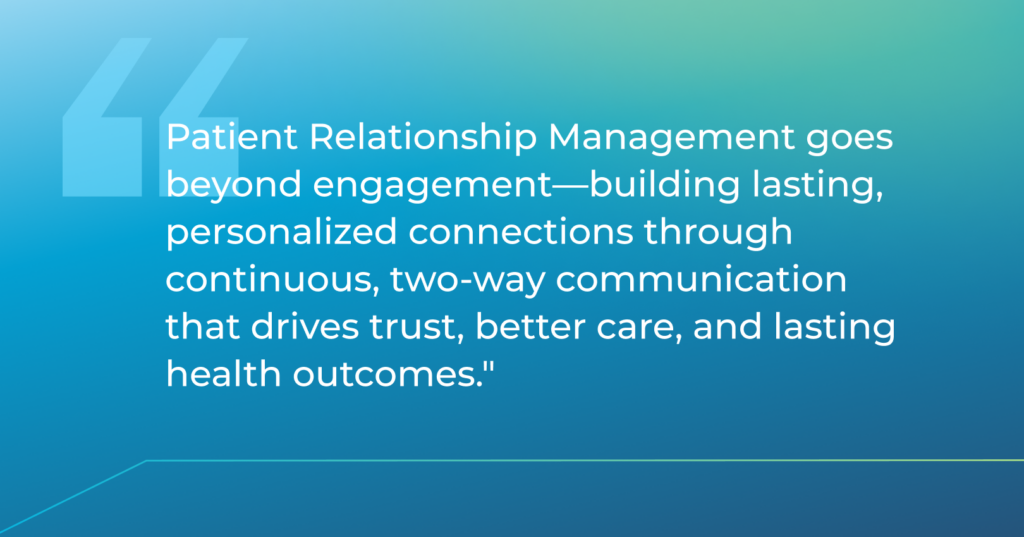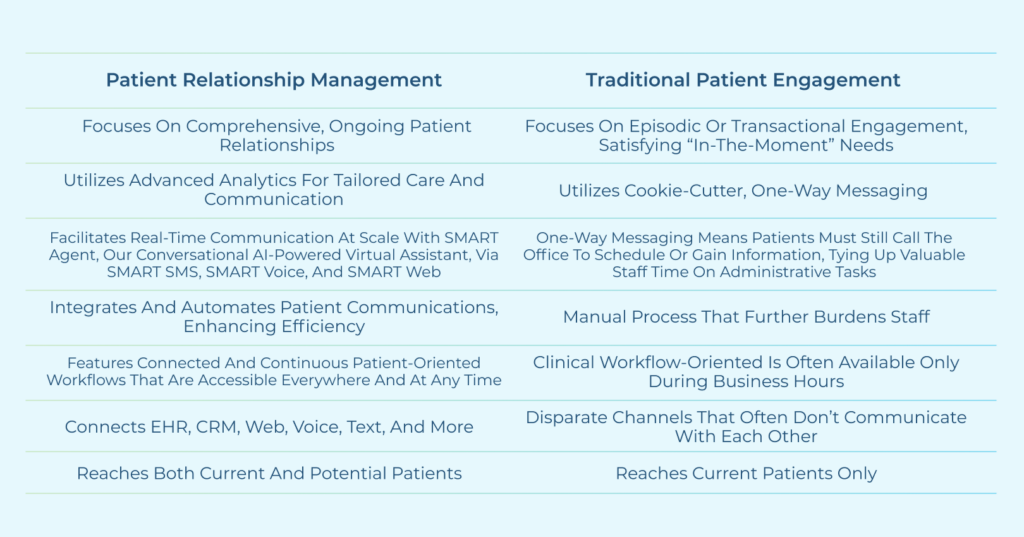Behavioral health care doesn’t end when a patient walks out of the clinic. Progress depends…

How Patient Relationship Management Is More Than Patient Engagement
When couples decide to get married, they typically have an engagement period. It’s an exciting time for sure, with several decisions to make on wedding details and honeymoon destinations. But ultimately, the engagement period is meant to be temporary. The more meaningful milestone is the marriage itself, and the years that follow.
Keeping that example in mind, we can apply the same logic to the patient/provider dynamic. Office visits and one-way text messages may keep the patient engaged temporarily, but to be successful and deliver the most impactful outcomes, providers must build an ongoing relationship with their patients.
True success only comes when healthcare providers invest in building a real relationship that comprises trust, communication, and continuity of care. That is why TeleVox is proud to lead the way in offering Patient Relationship Management (PRM) solutions to the healthcare industry. We value long-term, personalized relationships through sustained, meaningful, and bi-directional communications.
In this blog post, we’ll explore why PRM is essential, how it differs from traditional patient engagement tactics, and what providers can do to strengthen these relationships at scale.
What’s Patient Relationship Management (PRM)?
For healthcare organizations, patient relationship management is a way to build positive relationships with their patients. It involves tools and strategies to improve communication at every touchpoint and deliver exceptional patient experiences.
Remember that PRM is not new to healthcare. What is new, though, is that patient engagement is no longer a one-way communication. Technology has successfully transformed engagement into a two-way street, providing patients with a voice and making them active players in their own healthcare process. It’s a win-win for providers and patients.
Today, the best PRM systems are centralized to give healthcare providers a holistic view of patients’ ongoing experience. These smart systems track patients throughout their journey, giving critical insights to help providers deliver personalized care, anticipate needs, proactively address concerns, and generally make data-driven decisions for better health outcomes.
Key Differences Between PRM and Traditional Patient Engagement
Unlike episodic patient engagement, PRM emphasizes continuous, data-driven interaction, enhancing patient experiences and outcomes while offering significant operational and financial benefits to physician offices and healthcare systems.
Let’s explore how PRM differs from traditional patient engagement:
Value of Patient Relationship Management for Healthcare Providers
Every healthcare organization needs to consider implementing a PRM system to track, manage, and improve patient engagement. Below, we discuss some of the top reasons why.
Patient Retention and Loyalty
Credibility is important in the healthcare sector because patients only stick with providers they trust, and trust is earned when patients feel valued, not because the front-desk staff remembered their name.
PRM systems keep a record of patient preferences and their communication history, allowing staff and medical professionals to tailor their interactions accordingly. This personalized approach also extends to easy scheduling options and flagging important follow-ups based on patient needs.
Reduced No-Shows and Missed Follow-Ups
Healthcare providers lose billions annually due to missed or cancelled appointments. PRM systems help address that by sending automatic reminders and giving patients the option to quickly and easily reschedule. More advanced systems can even track patterns of missed appointments to identify at-risk patients for providers to specifically target.
When patients start showing up for appointments, they experience better health outcomes, and in turn, providers see improved revenue.
Better Health Outcomes
As already pointed out, PRM strategies work towards better health results because they promote better patient engagement. For instance, giving patients channels for them to ask quick questions between visits or a portal for them to go through educational materials relevant to their conditions.
Most PRM systems can also be set to send timely reminders for refills, which saves significant time and prevents missed doses, especially for elderly or disabled patients who may struggle with adherence.
Competitive Advantage
Yet another manner in which PRM delivers value to healthcare organizations is by providing them with an edge in the competitive healthcare market. Satisfied patients result in word-of-mouth endorsements and positive patient testimonials, drawing in additional patients. That is why establishing a reputation for exceptional service and convenience pays dividends in the long term.
Key Components of an Effective Patient Relationship Management Strategy
Think of an effective PRM system as a machine made up of several working parts. Each component plays a crucial role in keeping the entire system running. With that in mind, let’s take a closer look at some of the most important ones.
Seamless Integration With EHRs and CRM Systems
It’s important that a PRM connects directly with your existing EHR and CRM systems. This helps staff access patient information from a single platform. This also makes it possible for different branches to work together, so if a patient visits an out-of-city provider, their history and recent treatments will be easily accessible. The same goes for other information such as insurance details, contact, etc.
In addition, pulling data directly from PRM reduces the chances of data entry errors. Staff members also spend less time rummaging through paperwork. These factors improve operational efficiency across all departments and enable providers to quickly move from diagnosis to treatment.
Segmentation and Personalization
PRM systems organize data by classifying patients according to certain criteria such as appointment history or health conditions. This allows healthcare organizations to build focused outreach, like reminding patients about preventive care or scheduling follow-ups. A great example was during the COVID-19 pandemic when providers utilized PRM databases to monitor at-risk patients and remind patients for their vaccination shots.
Omnichannel Approach
Every patient has a preferred communication channel, which healthcare providers should respect. When patients can choose how they interact with their healthcare providers, response rates improve. Hence, a good PRM strategy here would be to offer multiple contact options instead of limiting patients to just what the provider wants.
Text messaging is best for appointment reminders, while emails are excellent for educational reminders. Phone calls are preferred for long or complex discussions, and online portals are used to quickly view test results.
Automation
Automation is the future of healthcare. AI-driven PRMs can handle routine tasks like appointment reminders, insurance verification, answering common questions, conducting surveys, etc. Healthcare organizations get to remove a lot of administrative burden from their staff, freeing them to focus their time and effort on delivering actual patient care.
Analytics and Tracking
Another key component of an effective PRM strategy is collecting and analyzing patient data. Every interaction, query, test result, treatment outcome, etc, is vital for medical professionals. Healthcare organizations can use this data to improve their own services as well as to spot problems early. For instance, providers can use PRMs to identify patients who need additional support between visits to significantly reduce hospital readmissions.
Consent and Compliance
Effective PRMs maintain detailed records of patient communication preferences and required authorizations, tracking HIPAA consent forms, communication opt-ins, marketing permissions, and documentation timestamps. This comprehensive record-keeping protects both patients and providers, helping healthcare organizations prevent regulatory issues through clear consent documentation and strict adherence to patient preferences.
Choosing the Right Patient Relationship Management System
While PRM features can vary from vendor to vendor, healthcare organizations should always focus on the following capabilities when looking to invest in a solution:
- Compatibility: Always check beforehand if a software solution can easily integrate with your existing systems. Trying to brute force newer technologies often results in service disruptions, broken features, and frustrated staff.
- Automation: It goes without saying that AI-driven automation is a cornerstone of effective PRM strategies. Confirm which tasks you want to automate and verify whether your chosen PRM can handle them. This list commonly includes appointment scheduling and reminders, surveys, preventive care alerts, etc.
- Data Security and Compliance: Ensure that the software strictly complies with all relevant regulations, such as HIPAA, to avoid penalties or worse, sanctions. This is to safeguard your patient information from security breaches and guarantee that all messaging is for authorized eyes only.
- Scalability and Flexibility: PRMs enable your healthcare organization to grow, but make sure it can equally grow with you. Reach out to other providers using the software and confirm how well the system sustains itself during peak days.
- Support and Training: Even the best systems fail without proper vendor support. Check the level of assistance during implementation, their response times, any training options for new staff, and how often they roll out updates and improvements.
- Reporting and Analytics: Your PRM should have the capabilities of collecting and analyzing data. Review their analytical dashboards to see the depth and presentation of data, and how well they deliver reports.

How to Measure the Effectiveness of Your Patient Relationship Management Efforts
There are a few KPIs that healthcare organizations can specifically use to measure whether their new patient relationship management system has made a positive difference. These metrics also help in measuring the ROI of your investment in the solution.
Patient Satisfaction Scores
Track feedback through post-visit surveys with specific questions about communication clarity and staff responsiveness. Many practices use the Net Promoter Score or 5-point rating scales to quantify patient experiences and identify specific improvement areas.
Formula: Net Promoter Score = % Promoters (9-10 ratings) – % Detractors (0-6 ratings)
Patient Retention Rates
Calculate the percentage of patients who return for follow-up care within appropriate timeframes. Compare current retention numbers to baseline data from before PRM implementation to see the actual impact on patient loyalty and continued care.
Formula: Retention Rate = (Total Patients – New Patients) ÷ Patients at Start of Period × 100
Treatment Outcomes
Monitor clinical metrics related to patient adherence to care plans, such as completed follow-up appointments and prescription refill rates. These measurements show whether improved communication through your PRM correlates with better health results.
Formula: Adherence Rate = Number of Completed Follow-ups ÷ Number of Scheduled Follow-ups × a00
Cost Savings
Document reductions in no-shows, staff time spent on routine calls, and paper-based communication expenses. Many practices find PRM systems pay for themselves through decreased administrative costs and more efficient scheduling.
Formula: ROI = (Cost Savings – PRM Cost) ÷ PRM Cost × 100
Take the Next Step Toward Better Patient Relationships
The future of Patient Relationship Management is here, and it’s powered by TeleVox’s AI-driven SMART Agent. We’re talking more than just basic automation. Our intelligent, omnichannel PRM solution delivers a human-like experience through natural conversations, multi-language support, and self-service capabilities that work across phone, text, and online chat. It doesn’t just answer patient questions; it guides them with personalized care, anytime they need it.
Our SMART tech integrates with your EHR systems with ease, and it’s also HIPAA-compliant to secure all your messaging channels.
With 91% of healthcare IT executives prioritizing patient experience, there’s never been a better time to adopt a next-generation PRM solution that meets modern expectations and solves real-world challenges.
Ready to experience the AI-powered future of patient engagement? Schedule a demo today, and our specialist will get back to you as soon as possible.




